In-Depth Analysis: Australian Dollar Inflation and Deflation Trends
VerifiedAdded on 2023/06/14
|32
|7593
|326
Report
AI Summary
This report examines the history and background of inflation and deflation concerning the Australian dollar (AUD), the fifth most traded currency, making it susceptible to various market forces. It reviews existing literature, identifies gaps, and analyzes the AUD in comparison to the Bangladesh Taka (BDT) using historical inflation and deflation data. The report investigates the causes of these economic phenomena affecting the AUD and incorporates a household survey to understand their impact and improve related monetary policies. The analysis includes the Australian economy’s service-based nature, its sensitivity to commodity prices, and unique relationships with Asian markets, particularly China. The report also touches on how inflation could simply be described as the constant increase in the price of goods and services resulting to increase in the cost of living, the price of goods bought today will have a decrease in quantity at the same price tomorrow and how deflation is described as the economic occurrence where money becomes less available without any effect of the normal production an economy has, leading to the reduction of prices of goods and services, an extend case of deflation of a currency will generally lead to reduced production and increase in unemployment. It references key economic figures and events, such as the Asian financial crisis and the emergence of cryptocurrencies, to provide a comprehensive overview of the factors influencing the AUD's inflationary and deflationary trends.

Paraphrase This Document
Need a fresh take? Get an instant paraphrase of this document with our AI Paraphraser

Australian dollar inflation and deflation 2
Executive summary
A look at the history and background of deflation and inflation for the Australian dollar will be
conducted in this paper, However since Australian dollar is the fifth most traded currency in the
stock market, this means that its open and prune to many force and shocks that will affect the
currency, this will also be illustrated in the paper The paper will also discuss the various
literature reviews concerning inflation and deflation in relation to Australian currency while
identifying the various gaps in the literature. A analysis of the Australian dollar will be
conducted in comparison to the Bangladesh taka(BDT) by conduction an analysis of its historical
inflation and deflation data in the long run. Through this, the causes of deflation and inflation of
the Australian dollar will have to be conducted Finally a household survey will be conducted for
the purpose of expounding on inflation and deflation of the Australian dollar in respect to the
enhancing of the monetary policies related in curbing the two
Executive summary
A look at the history and background of deflation and inflation for the Australian dollar will be
conducted in this paper, However since Australian dollar is the fifth most traded currency in the
stock market, this means that its open and prune to many force and shocks that will affect the
currency, this will also be illustrated in the paper The paper will also discuss the various
literature reviews concerning inflation and deflation in relation to Australian currency while
identifying the various gaps in the literature. A analysis of the Australian dollar will be
conducted in comparison to the Bangladesh taka(BDT) by conduction an analysis of its historical
inflation and deflation data in the long run. Through this, the causes of deflation and inflation of
the Australian dollar will have to be conducted Finally a household survey will be conducted for
the purpose of expounding on inflation and deflation of the Australian dollar in respect to the
enhancing of the monetary policies related in curbing the two
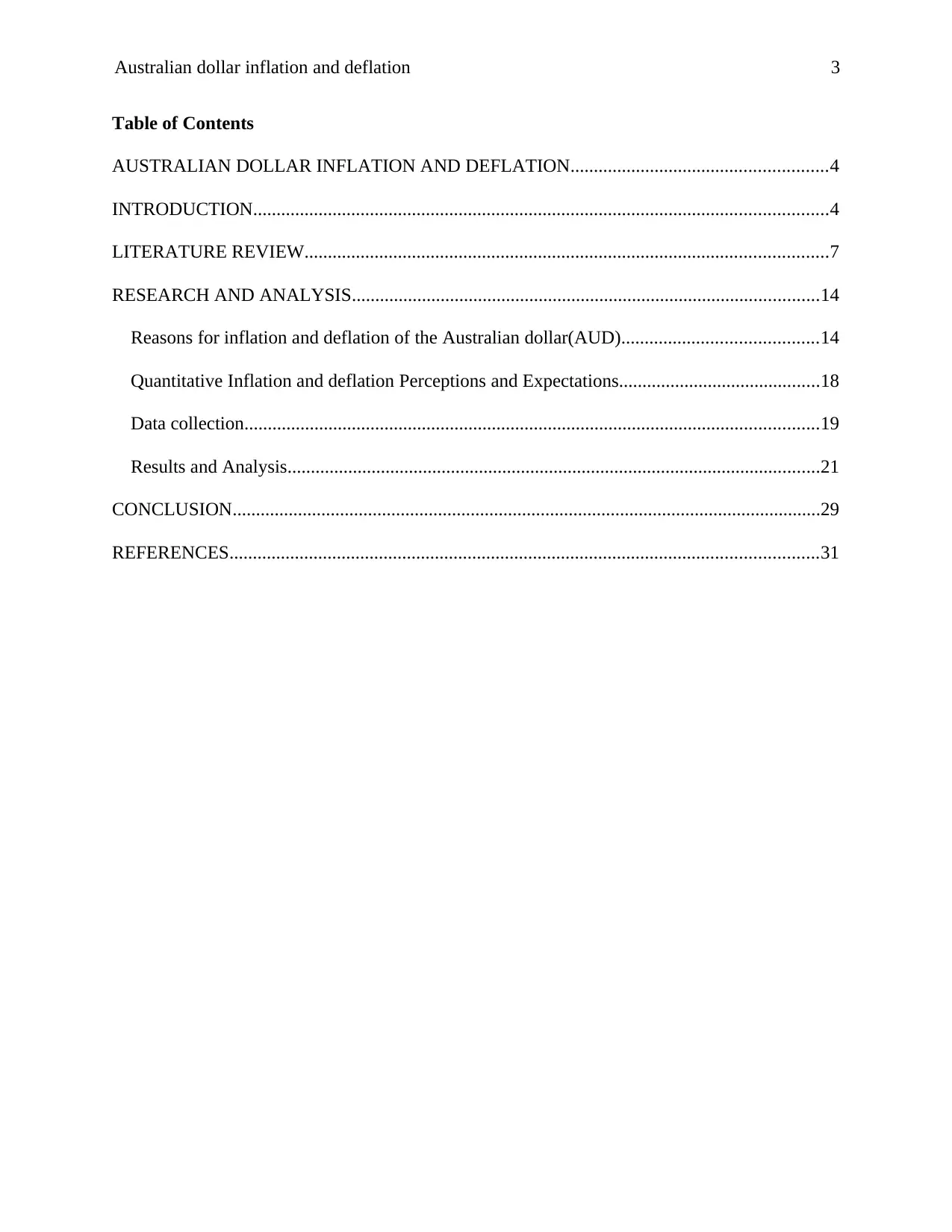
Australian dollar inflation and deflation 3
Table of Contents
AUSTRALIAN DOLLAR INFLATION AND DEFLATION.......................................................4
INTRODUCTION...........................................................................................................................4
LITERATURE REVIEW................................................................................................................7
RESEARCH AND ANALYSIS....................................................................................................14
Reasons for inflation and deflation of the Australian dollar(AUD)..........................................14
Quantitative Inflation and deflation Perceptions and Expectations...........................................18
Data collection...........................................................................................................................19
Results and Analysis..................................................................................................................21
CONCLUSION..............................................................................................................................29
REFERENCES..............................................................................................................................31
Table of Contents
AUSTRALIAN DOLLAR INFLATION AND DEFLATION.......................................................4
INTRODUCTION...........................................................................................................................4
LITERATURE REVIEW................................................................................................................7
RESEARCH AND ANALYSIS....................................................................................................14
Reasons for inflation and deflation of the Australian dollar(AUD)..........................................14
Quantitative Inflation and deflation Perceptions and Expectations...........................................18
Data collection...........................................................................................................................19
Results and Analysis..................................................................................................................21
CONCLUSION..............................................................................................................................29
REFERENCES..............................................................................................................................31
⊘ This is a preview!⊘
Do you want full access?
Subscribe today to unlock all pages.

Trusted by 1+ million students worldwide
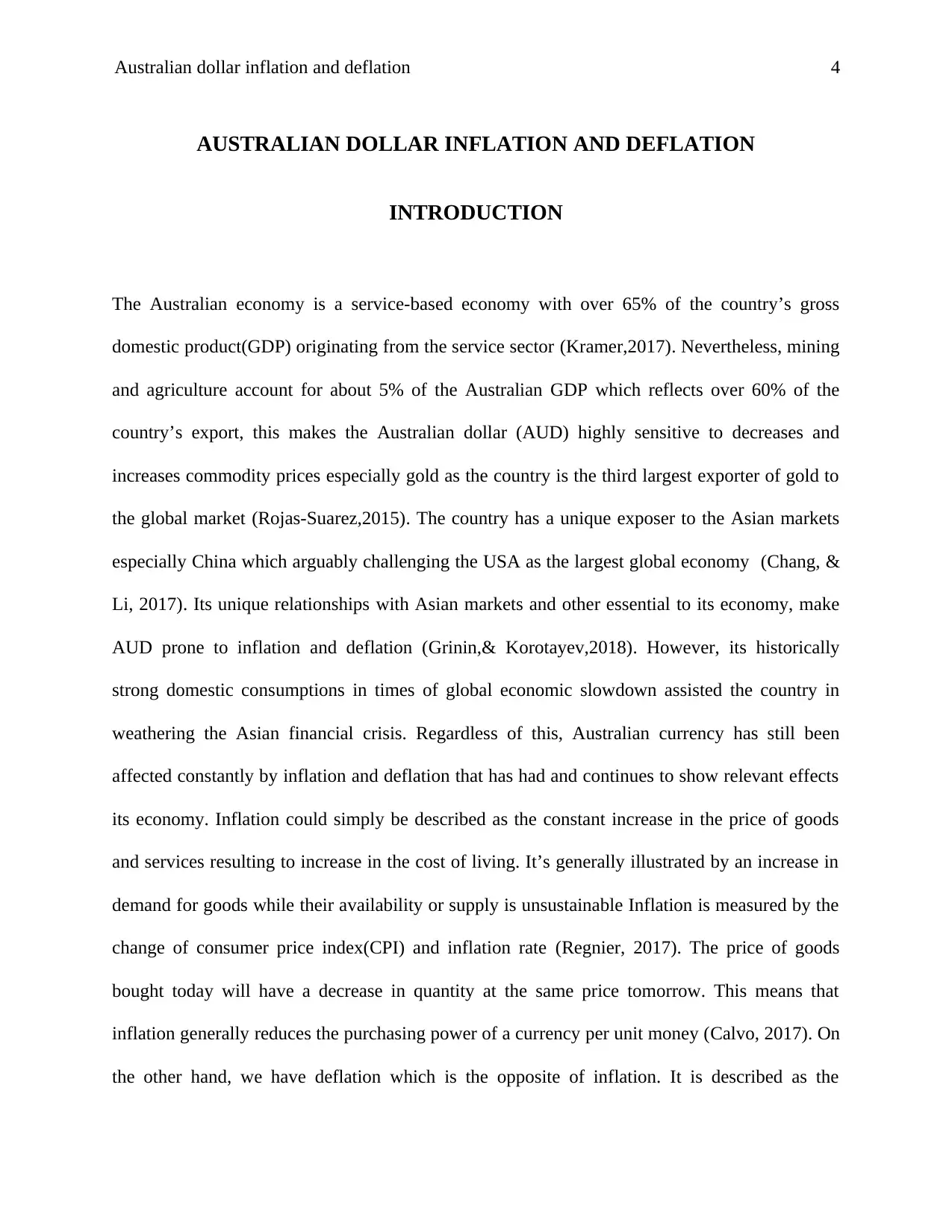
Australian dollar inflation and deflation 4
AUSTRALIAN DOLLAR INFLATION AND DEFLATION
INTRODUCTION
The Australian economy is a service-based economy with over 65% of the country’s gross
domestic product(GDP) originating from the service sector (Kramer,2017). Nevertheless, mining
and agriculture account for about 5% of the Australian GDP which reflects over 60% of the
country’s export, this makes the Australian dollar (AUD) highly sensitive to decreases and
increases commodity prices especially gold as the country is the third largest exporter of gold to
the global market (Rojas-Suarez,2015). The country has a unique exposer to the Asian markets
especially China which arguably challenging the USA as the largest global economy (Chang, &
Li, 2017). Its unique relationships with Asian markets and other essential to its economy, make
AUD prone to inflation and deflation (Grinin,& Korotayev,2018). However, its historically
strong domestic consumptions in times of global economic slowdown assisted the country in
weathering the Asian financial crisis. Regardless of this, Australian currency has still been
affected constantly by inflation and deflation that has had and continues to show relevant effects
its economy. Inflation could simply be described as the constant increase in the price of goods
and services resulting to increase in the cost of living. It’s generally illustrated by an increase in
demand for goods while their availability or supply is unsustainable Inflation is measured by the
change of consumer price index(CPI) and inflation rate (Regnier, 2017). The price of goods
bought today will have a decrease in quantity at the same price tomorrow. This means that
inflation generally reduces the purchasing power of a currency per unit money (Calvo, 2017). On
the other hand, we have deflation which is the opposite of inflation. It is described as the
AUSTRALIAN DOLLAR INFLATION AND DEFLATION
INTRODUCTION
The Australian economy is a service-based economy with over 65% of the country’s gross
domestic product(GDP) originating from the service sector (Kramer,2017). Nevertheless, mining
and agriculture account for about 5% of the Australian GDP which reflects over 60% of the
country’s export, this makes the Australian dollar (AUD) highly sensitive to decreases and
increases commodity prices especially gold as the country is the third largest exporter of gold to
the global market (Rojas-Suarez,2015). The country has a unique exposer to the Asian markets
especially China which arguably challenging the USA as the largest global economy (Chang, &
Li, 2017). Its unique relationships with Asian markets and other essential to its economy, make
AUD prone to inflation and deflation (Grinin,& Korotayev,2018). However, its historically
strong domestic consumptions in times of global economic slowdown assisted the country in
weathering the Asian financial crisis. Regardless of this, Australian currency has still been
affected constantly by inflation and deflation that has had and continues to show relevant effects
its economy. Inflation could simply be described as the constant increase in the price of goods
and services resulting to increase in the cost of living. It’s generally illustrated by an increase in
demand for goods while their availability or supply is unsustainable Inflation is measured by the
change of consumer price index(CPI) and inflation rate (Regnier, 2017). The price of goods
bought today will have a decrease in quantity at the same price tomorrow. This means that
inflation generally reduces the purchasing power of a currency per unit money (Calvo, 2017). On
the other hand, we have deflation which is the opposite of inflation. It is described as the
Paraphrase This Document
Need a fresh take? Get an instant paraphrase of this document with our AI Paraphraser
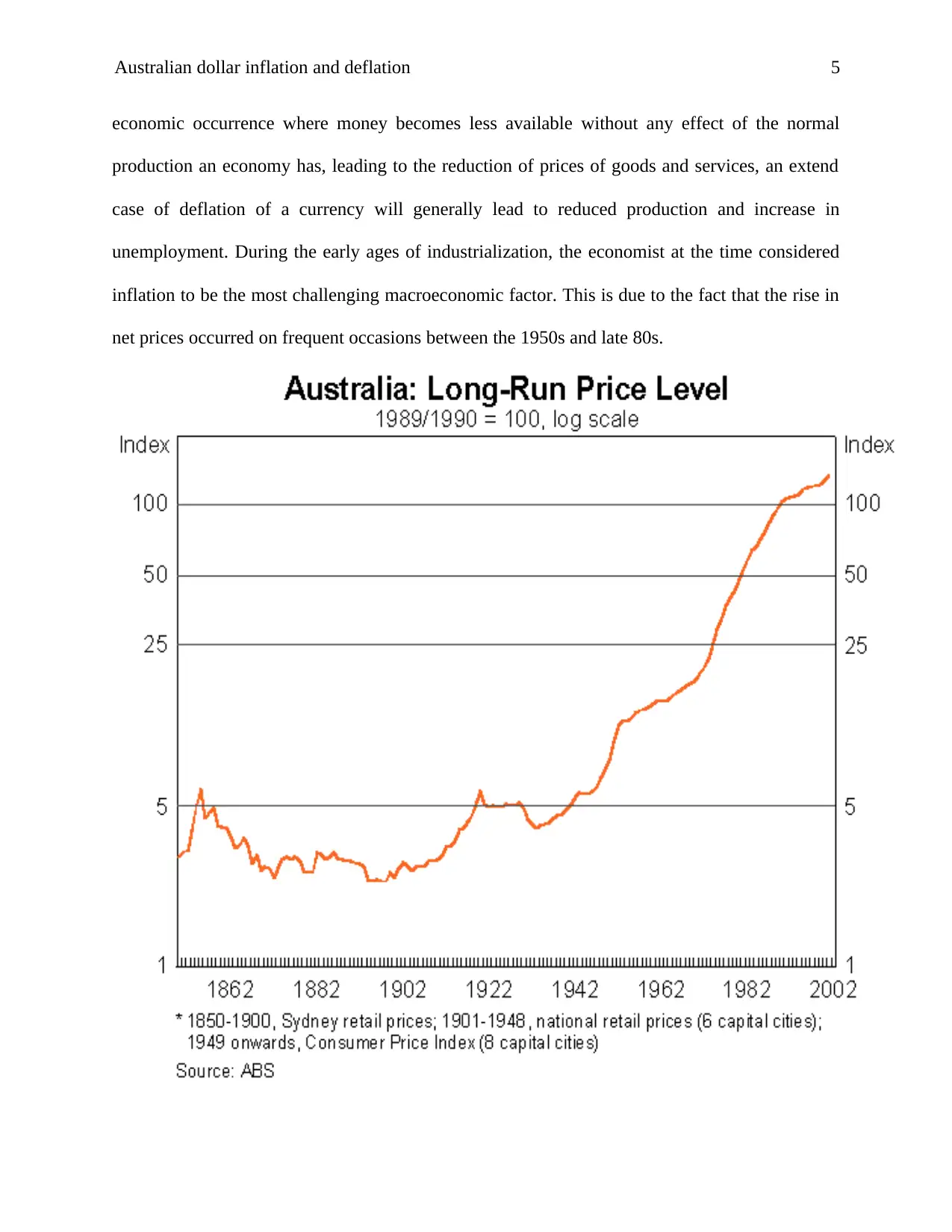
Australian dollar inflation and deflation 5
economic occurrence where money becomes less available without any effect of the normal
production an economy has, leading to the reduction of prices of goods and services, an extend
case of deflation of a currency will generally lead to reduced production and increase in
unemployment. During the early ages of industrialization, the economist at the time considered
inflation to be the most challenging macroeconomic factor. This is due to the fact that the rise in
net prices occurred on frequent occasions between the 1950s and late 80s.
economic occurrence where money becomes less available without any effect of the normal
production an economy has, leading to the reduction of prices of goods and services, an extend
case of deflation of a currency will generally lead to reduced production and increase in
unemployment. During the early ages of industrialization, the economist at the time considered
inflation to be the most challenging macroeconomic factor. This is due to the fact that the rise in
net prices occurred on frequent occasions between the 1950s and late 80s.

Australian dollar inflation and deflation 6
For Australia's situation, it was perceptible amid the 1950s that, in times of business cycle
downturn, costs quit rising yet didn't really fall. This was rather than the pre-World War II
encounter, where value levels fell amid retreats (Calvo, 2016). By the second 50% of the 1960s,
it was much clearer that the value level had obtained a determined upward pattern, and around
that time it ended up typical to take a gander at the value level in its first distinction frame as
opposed to its level. However, everything changed with the all-time high 20%inflation that
nearly destroyed the economy, monetary policies were created for the purpose of curbing
Australia’s inflation-deflation in the 70s.Inflation continued to the subdue the global economy
for a decade up to the the1990s (Anderson, Bordo & Duca, 2017).
The ensuing decade has been a time of low inflation globally. Most as of late, with a worldwide
business cycle downturn, inflation all around has declined further and is as of now low to
minimal in many spots. So, it is normal to ask whether, after an age agonizing over inflation, we
may be looked with deflation. Surely the word 'deflation' is utilized with considerably more
prominent recurrence than it has been for quite a while. Its utilization, as a rule, invokes some
dubious thought of the Great Depression, which was the last time a broad emptying occurrence.
So, it merits in looking at this in more detail. I need initially to be clear what we mean by empty,
at that point to ask whether it is in reality happening (Watanabe & Watanabe,2018). At that point
I need to get some information about it and assuming this is the case, what we may do to counter
it This paper will discuss the Australian dollar inflation and deflation while reviewing it current
For Australia's situation, it was perceptible amid the 1950s that, in times of business cycle
downturn, costs quit rising yet didn't really fall. This was rather than the pre-World War II
encounter, where value levels fell amid retreats (Calvo, 2016). By the second 50% of the 1960s,
it was much clearer that the value level had obtained a determined upward pattern, and around
that time it ended up typical to take a gander at the value level in its first distinction frame as
opposed to its level. However, everything changed with the all-time high 20%inflation that
nearly destroyed the economy, monetary policies were created for the purpose of curbing
Australia’s inflation-deflation in the 70s.Inflation continued to the subdue the global economy
for a decade up to the the1990s (Anderson, Bordo & Duca, 2017).
The ensuing decade has been a time of low inflation globally. Most as of late, with a worldwide
business cycle downturn, inflation all around has declined further and is as of now low to
minimal in many spots. So, it is normal to ask whether, after an age agonizing over inflation, we
may be looked with deflation. Surely the word 'deflation' is utilized with considerably more
prominent recurrence than it has been for quite a while. Its utilization, as a rule, invokes some
dubious thought of the Great Depression, which was the last time a broad emptying occurrence.
So, it merits in looking at this in more detail. I need initially to be clear what we mean by empty,
at that point to ask whether it is in reality happening (Watanabe & Watanabe,2018). At that point
I need to get some information about it and assuming this is the case, what we may do to counter
it This paper will discuss the Australian dollar inflation and deflation while reviewing it current
⊘ This is a preview!⊘
Do you want full access?
Subscribe today to unlock all pages.

Trusted by 1+ million students worldwide

Australian dollar inflation and deflation 7
literature. Later in this paper research analysis will be conducted while making a comparison to
the Bangladesh currency.
LITERATURE REVIEW
The rigs of the word inflation can be credited to linguistics of the early days; the Latins "to blow
into". It credits it understanding accurately as the irregular increase in prices regardless of
changes in relative scarcity which has been occurring throughout over the centuries. without
success, Diocletian attempted to check inflation in Roman during the fourth century. The typical
cost for basic items in medieval Europe climbed fourfold; in the vicinity of 1520 and 1650, costs
again ascended in the vicinity of 200 and 400 for each penny, to a great extent because of gold
filling Europe from the recently opened mines of the New World. In numerous cases, inflation
was, in any case, trailed by resulting times of deflation (Apergis,2014). Diocletian in his quest to
contain inflation was not convinced of how the measures he took gave poor results. He resulted
in fixing prices of crucial and essentials items and gave a death penalty to anyone who sold such
goods at their own prices (Dillon, 2014). This is a good example of price controls but it
inevitably failed.
Bryan contradicts the earlier understanding of inflation by shifting the focus from prices to the
physical tangible paper money by offering solutions through monetary policies. However many
scholars don’t fully agree with his argument since an increase on the complex world economy is
literature. Later in this paper research analysis will be conducted while making a comparison to
the Bangladesh currency.
LITERATURE REVIEW
The rigs of the word inflation can be credited to linguistics of the early days; the Latins "to blow
into". It credits it understanding accurately as the irregular increase in prices regardless of
changes in relative scarcity which has been occurring throughout over the centuries. without
success, Diocletian attempted to check inflation in Roman during the fourth century. The typical
cost for basic items in medieval Europe climbed fourfold; in the vicinity of 1520 and 1650, costs
again ascended in the vicinity of 200 and 400 for each penny, to a great extent because of gold
filling Europe from the recently opened mines of the New World. In numerous cases, inflation
was, in any case, trailed by resulting times of deflation (Apergis,2014). Diocletian in his quest to
contain inflation was not convinced of how the measures he took gave poor results. He resulted
in fixing prices of crucial and essentials items and gave a death penalty to anyone who sold such
goods at their own prices (Dillon, 2014). This is a good example of price controls but it
inevitably failed.
Bryan contradicts the earlier understanding of inflation by shifting the focus from prices to the
physical tangible paper money by offering solutions through monetary policies. However many
scholars don’t fully agree with his argument since an increase on the complex world economy is
Paraphrase This Document
Need a fresh take? Get an instant paraphrase of this document with our AI Paraphraser
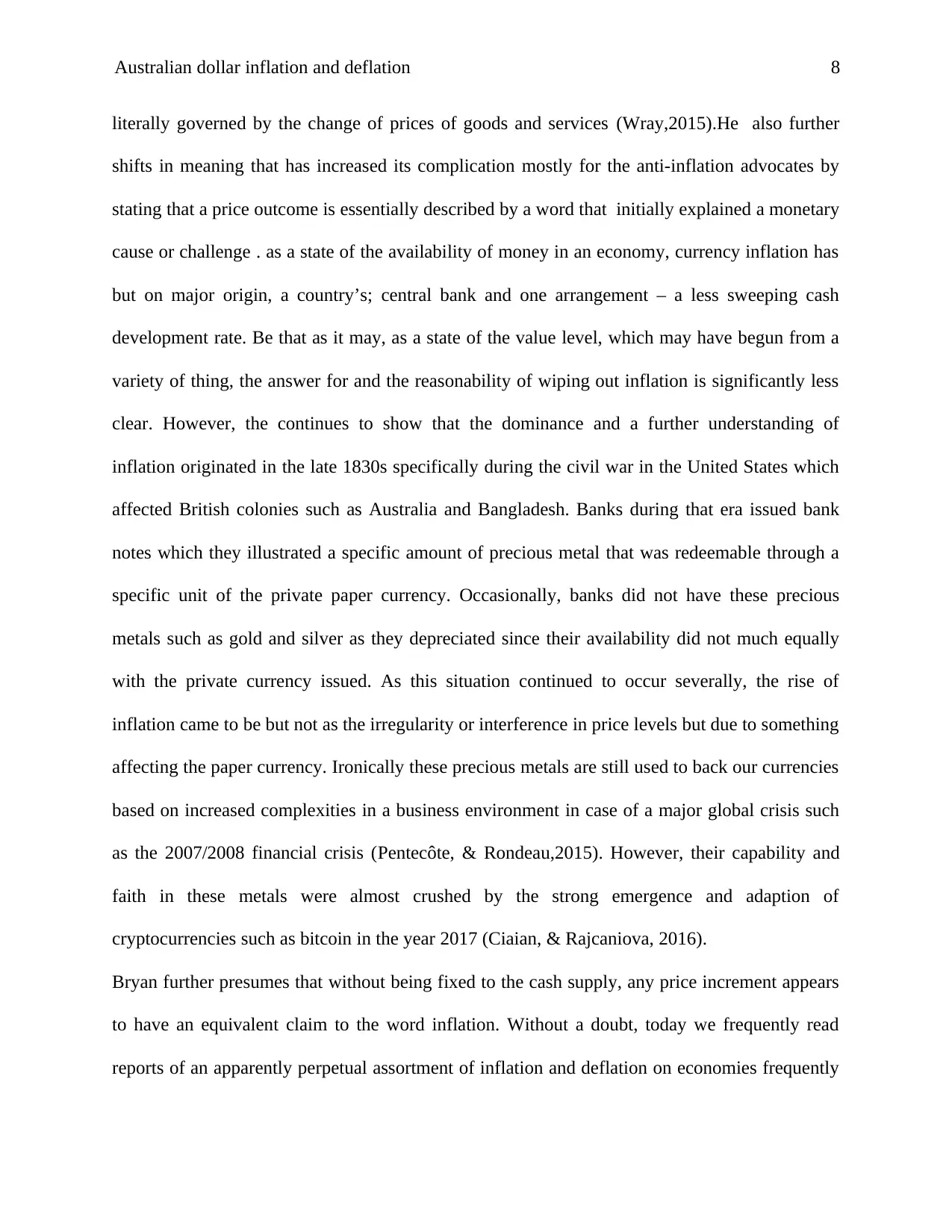
Australian dollar inflation and deflation 8
literally governed by the change of prices of goods and services (Wray,2015).He also further
shifts in meaning that has increased its complication mostly for the anti-inflation advocates by
stating that a price outcome is essentially described by a word that initially explained a monetary
cause or challenge . as a state of the availability of money in an economy, currency inflation has
but on major origin, a country’s; central bank and one arrangement – a less sweeping cash
development rate. Be that as it may, as a state of the value level, which may have begun from a
variety of thing, the answer for and the reasonability of wiping out inflation is significantly less
clear. However, the continues to show that the dominance and a further understanding of
inflation originated in the late 1830s specifically during the civil war in the United States which
affected British colonies such as Australia and Bangladesh. Banks during that era issued bank
notes which they illustrated a specific amount of precious metal that was redeemable through a
specific unit of the private paper currency. Occasionally, banks did not have these precious
metals such as gold and silver as they depreciated since their availability did not much equally
with the private currency issued. As this situation continued to occur severally, the rise of
inflation came to be but not as the irregularity or interference in price levels but due to something
affecting the paper currency. Ironically these precious metals are still used to back our currencies
based on increased complexities in a business environment in case of a major global crisis such
as the 2007/2008 financial crisis (Pentecôte, & Rondeau,2015). However, their capability and
faith in these metals were almost crushed by the strong emergence and adaption of
cryptocurrencies such as bitcoin in the year 2017 (Ciaian, & Rajcaniova, 2016).
Bryan further presumes that without being fixed to the cash supply, any price increment appears
to have an equivalent claim to the word inflation. Without a doubt, today we frequently read
reports of an apparently perpetual assortment of inflation and deflation on economies frequently
literally governed by the change of prices of goods and services (Wray,2015).He also further
shifts in meaning that has increased its complication mostly for the anti-inflation advocates by
stating that a price outcome is essentially described by a word that initially explained a monetary
cause or challenge . as a state of the availability of money in an economy, currency inflation has
but on major origin, a country’s; central bank and one arrangement – a less sweeping cash
development rate. Be that as it may, as a state of the value level, which may have begun from a
variety of thing, the answer for and the reasonability of wiping out inflation is significantly less
clear. However, the continues to show that the dominance and a further understanding of
inflation originated in the late 1830s specifically during the civil war in the United States which
affected British colonies such as Australia and Bangladesh. Banks during that era issued bank
notes which they illustrated a specific amount of precious metal that was redeemable through a
specific unit of the private paper currency. Occasionally, banks did not have these precious
metals such as gold and silver as they depreciated since their availability did not much equally
with the private currency issued. As this situation continued to occur severally, the rise of
inflation came to be but not as the irregularity or interference in price levels but due to something
affecting the paper currency. Ironically these precious metals are still used to back our currencies
based on increased complexities in a business environment in case of a major global crisis such
as the 2007/2008 financial crisis (Pentecôte, & Rondeau,2015). However, their capability and
faith in these metals were almost crushed by the strong emergence and adaption of
cryptocurrencies such as bitcoin in the year 2017 (Ciaian, & Rajcaniova, 2016).
Bryan further presumes that without being fixed to the cash supply, any price increment appears
to have an equivalent claim to the word inflation. Without a doubt, today we frequently read
reports of an apparently perpetual assortment of inflation and deflation on economies frequently
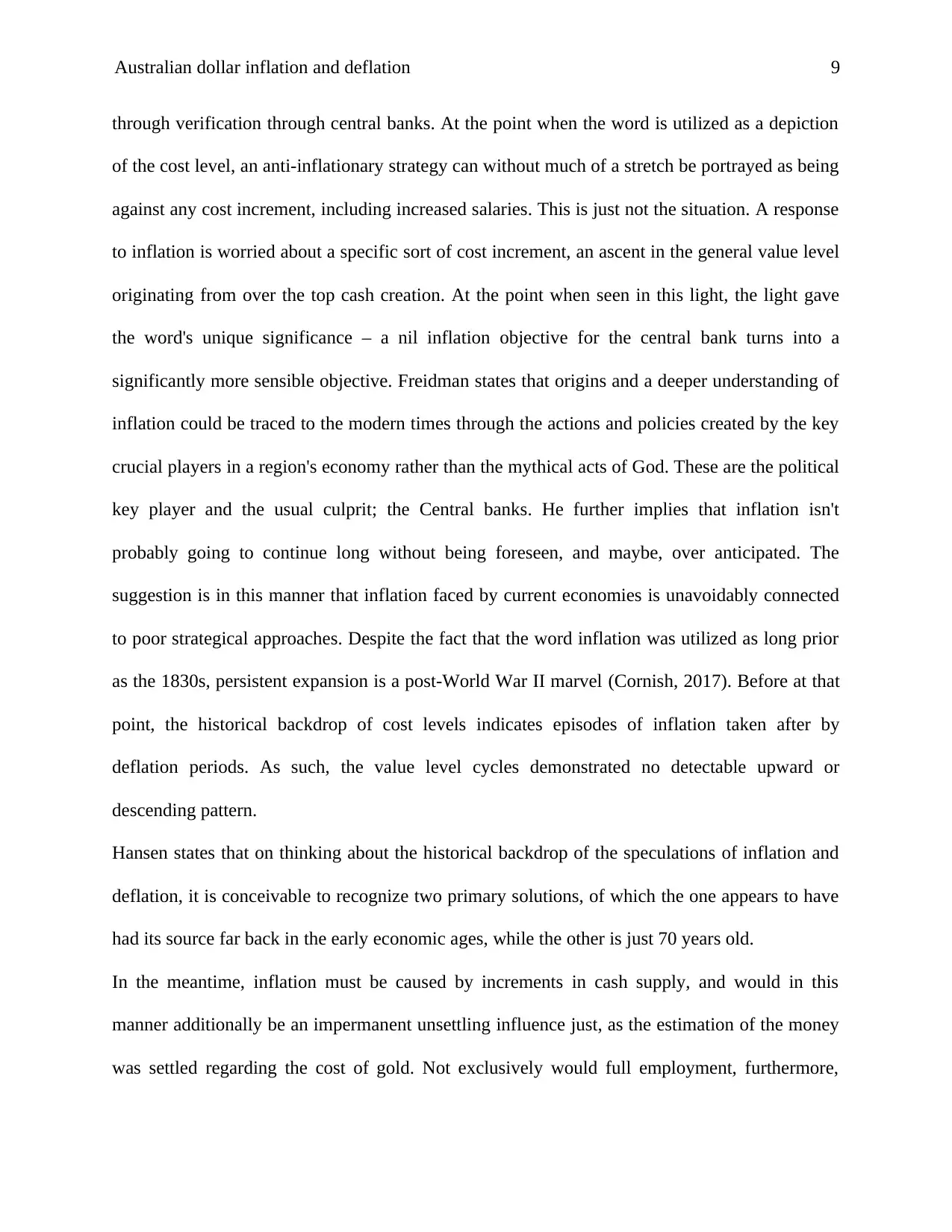
Australian dollar inflation and deflation 9
through verification through central banks. At the point when the word is utilized as a depiction
of the cost level, an anti-inflationary strategy can without much of a stretch be portrayed as being
against any cost increment, including increased salaries. This is just not the situation. A response
to inflation is worried about a specific sort of cost increment, an ascent in the general value level
originating from over the top cash creation. At the point when seen in this light, the light gave
the word's unique significance – a nil inflation objective for the central bank turns into a
significantly more sensible objective. Freidman states that origins and a deeper understanding of
inflation could be traced to the modern times through the actions and policies created by the key
crucial players in a region's economy rather than the mythical acts of God. These are the political
key player and the usual culprit; the Central banks. He further implies that inflation isn't
probably going to continue long without being foreseen, and maybe, over anticipated. The
suggestion is in this manner that inflation faced by current economies is unavoidably connected
to poor strategical approaches. Despite the fact that the word inflation was utilized as long prior
as the 1830s, persistent expansion is a post-World War II marvel (Cornish, 2017). Before at that
point, the historical backdrop of cost levels indicates episodes of inflation taken after by
deflation periods. As such, the value level cycles demonstrated no detectable upward or
descending pattern.
Hansen states that on thinking about the historical backdrop of the speculations of inflation and
deflation, it is conceivable to recognize two primary solutions, of which the one appears to have
had its source far back in the early economic ages, while the other is just 70 years old.
In the meantime, inflation must be caused by increments in cash supply, and would in this
manner additionally be an impermanent unsettling influence just, as the estimation of the money
was settled regarding the cost of gold. Not exclusively would full employment, furthermore,
through verification through central banks. At the point when the word is utilized as a depiction
of the cost level, an anti-inflationary strategy can without much of a stretch be portrayed as being
against any cost increment, including increased salaries. This is just not the situation. A response
to inflation is worried about a specific sort of cost increment, an ascent in the general value level
originating from over the top cash creation. At the point when seen in this light, the light gave
the word's unique significance – a nil inflation objective for the central bank turns into a
significantly more sensible objective. Freidman states that origins and a deeper understanding of
inflation could be traced to the modern times through the actions and policies created by the key
crucial players in a region's economy rather than the mythical acts of God. These are the political
key player and the usual culprit; the Central banks. He further implies that inflation isn't
probably going to continue long without being foreseen, and maybe, over anticipated. The
suggestion is in this manner that inflation faced by current economies is unavoidably connected
to poor strategical approaches. Despite the fact that the word inflation was utilized as long prior
as the 1830s, persistent expansion is a post-World War II marvel (Cornish, 2017). Before at that
point, the historical backdrop of cost levels indicates episodes of inflation taken after by
deflation periods. As such, the value level cycles demonstrated no detectable upward or
descending pattern.
Hansen states that on thinking about the historical backdrop of the speculations of inflation and
deflation, it is conceivable to recognize two primary solutions, of which the one appears to have
had its source far back in the early economic ages, while the other is just 70 years old.
In the meantime, inflation must be caused by increments in cash supply, and would in this
manner additionally be an impermanent unsettling influence just, as the estimation of the money
was settled regarding the cost of gold. Not exclusively would full employment, furthermore,
⊘ This is a preview!⊘
Do you want full access?
Subscribe today to unlock all pages.

Trusted by 1+ million students worldwide
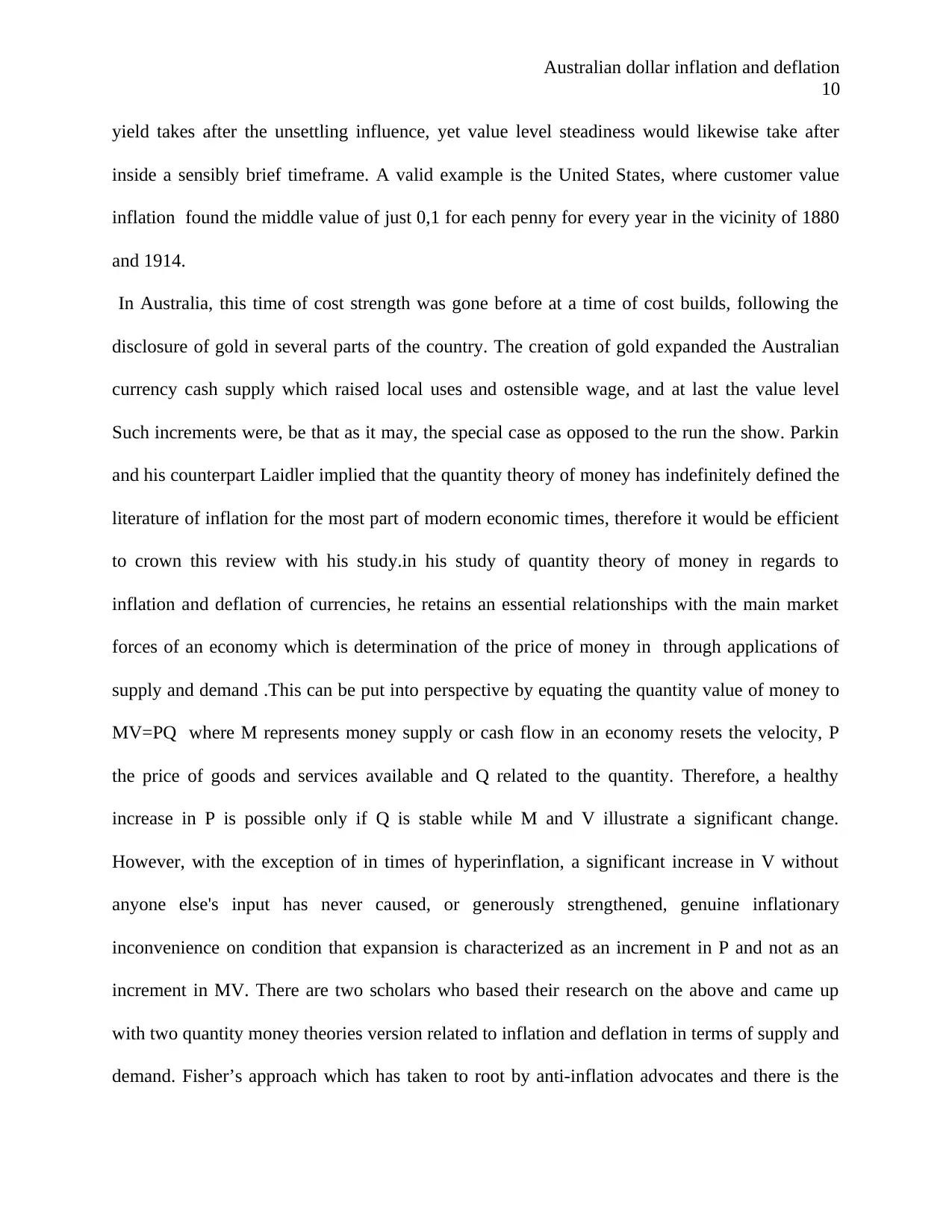
Australian dollar inflation and deflation
10
yield takes after the unsettling influence, yet value level steadiness would likewise take after
inside a sensibly brief timeframe. A valid example is the United States, where customer value
inflation found the middle value of just 0,1 for each penny for every year in the vicinity of 1880
and 1914.
In Australia, this time of cost strength was gone before at a time of cost builds, following the
disclosure of gold in several parts of the country. The creation of gold expanded the Australian
currency cash supply which raised local uses and ostensible wage, and at last the value level
Such increments were, be that as it may, the special case as opposed to the run the show. Parkin
and his counterpart Laidler implied that the quantity theory of money has indefinitely defined the
literature of inflation for the most part of modern economic times, therefore it would be efficient
to crown this review with his study.in his study of quantity theory of money in regards to
inflation and deflation of currencies, he retains an essential relationships with the main market
forces of an economy which is determination of the price of money in through applications of
supply and demand .This can be put into perspective by equating the quantity value of money to
MV=PQ where M represents money supply or cash flow in an economy resets the velocity, P
the price of goods and services available and Q related to the quantity. Therefore, a healthy
increase in P is possible only if Q is stable while M and V illustrate a significant change.
However, with the exception of in times of hyperinflation, a significant increase in V without
anyone else's input has never caused, or generously strengthened, genuine inflationary
inconvenience on condition that expansion is characterized as an increment in P and not as an
increment in MV. There are two scholars who based their research on the above and came up
with two quantity money theories version related to inflation and deflation in terms of supply and
demand. Fisher’s approach which has taken to root by anti-inflation advocates and there is the
10
yield takes after the unsettling influence, yet value level steadiness would likewise take after
inside a sensibly brief timeframe. A valid example is the United States, where customer value
inflation found the middle value of just 0,1 for each penny for every year in the vicinity of 1880
and 1914.
In Australia, this time of cost strength was gone before at a time of cost builds, following the
disclosure of gold in several parts of the country. The creation of gold expanded the Australian
currency cash supply which raised local uses and ostensible wage, and at last the value level
Such increments were, be that as it may, the special case as opposed to the run the show. Parkin
and his counterpart Laidler implied that the quantity theory of money has indefinitely defined the
literature of inflation for the most part of modern economic times, therefore it would be efficient
to crown this review with his study.in his study of quantity theory of money in regards to
inflation and deflation of currencies, he retains an essential relationships with the main market
forces of an economy which is determination of the price of money in through applications of
supply and demand .This can be put into perspective by equating the quantity value of money to
MV=PQ where M represents money supply or cash flow in an economy resets the velocity, P
the price of goods and services available and Q related to the quantity. Therefore, a healthy
increase in P is possible only if Q is stable while M and V illustrate a significant change.
However, with the exception of in times of hyperinflation, a significant increase in V without
anyone else's input has never caused, or generously strengthened, genuine inflationary
inconvenience on condition that expansion is characterized as an increment in P and not as an
increment in MV. There are two scholars who based their research on the above and came up
with two quantity money theories version related to inflation and deflation in terms of supply and
demand. Fisher’s approach which has taken to root by anti-inflation advocates and there is the
Paraphrase This Document
Need a fresh take? Get an instant paraphrase of this document with our AI Paraphraser
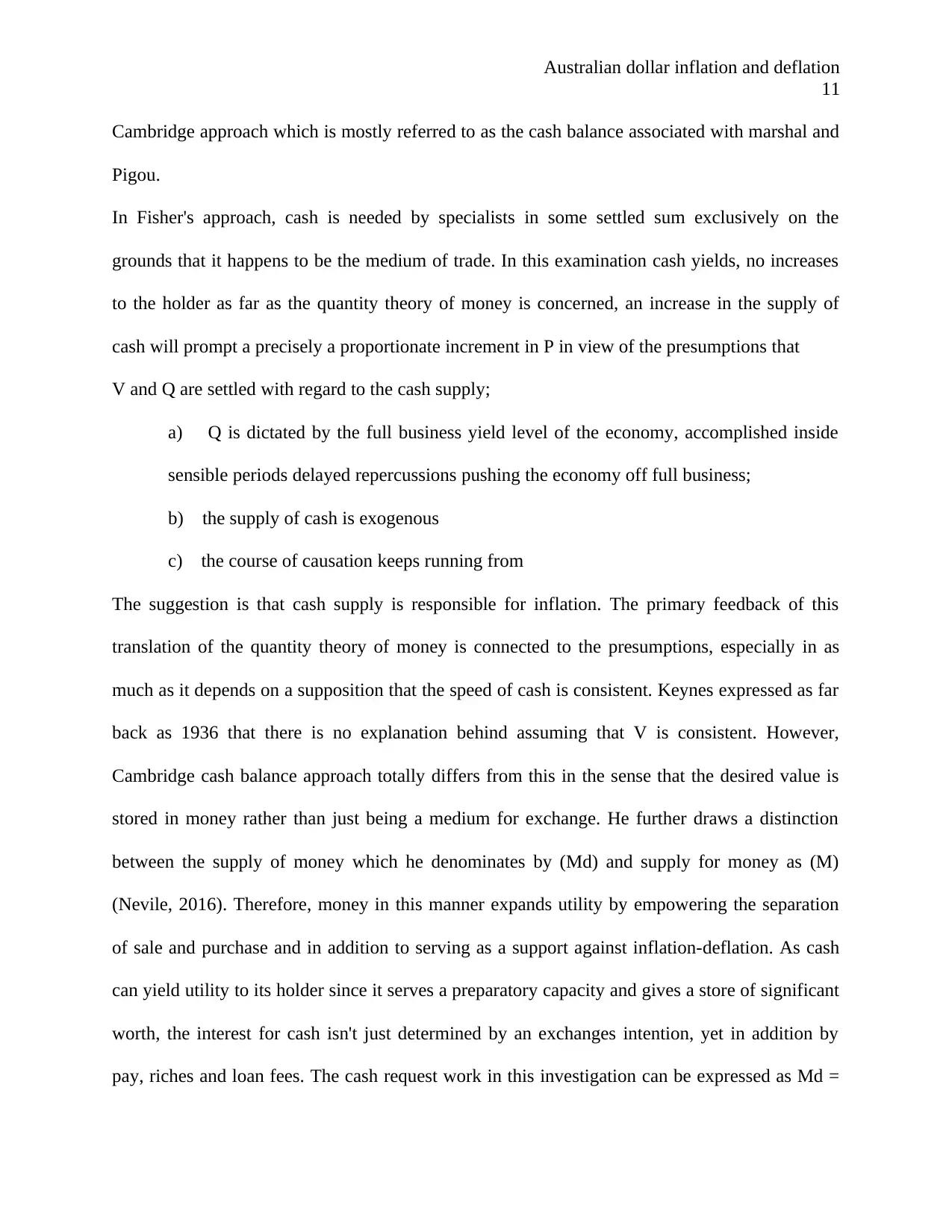
Australian dollar inflation and deflation
11
Cambridge approach which is mostly referred to as the cash balance associated with marshal and
Pigou.
In Fisher's approach, cash is needed by specialists in some settled sum exclusively on the
grounds that it happens to be the medium of trade. In this examination cash yields, no increases
to the holder as far as the quantity theory of money is concerned, an increase in the supply of
cash will prompt a precisely a proportionate increment in P in view of the presumptions that
V and Q are settled with regard to the cash supply;
a) Q is dictated by the full business yield level of the economy, accomplished inside
sensible periods delayed repercussions pushing the economy off full business;
b) the supply of cash is exogenous
c) the course of causation keeps running from
The suggestion is that cash supply is responsible for inflation. The primary feedback of this
translation of the quantity theory of money is connected to the presumptions, especially in as
much as it depends on a supposition that the speed of cash is consistent. Keynes expressed as far
back as 1936 that there is no explanation behind assuming that V is consistent. However,
Cambridge cash balance approach totally differs from this in the sense that the desired value is
stored in money rather than just being a medium for exchange. He further draws a distinction
between the supply of money which he denominates by (Md) and supply for money as (M)
(Nevile, 2016). Therefore, money in this manner expands utility by empowering the separation
of sale and purchase and in addition to serving as a support against inflation-deflation. As cash
can yield utility to its holder since it serves a preparatory capacity and gives a store of significant
worth, the interest for cash isn't just determined by an exchanges intention, yet in addition by
pay, riches and loan fees. The cash request work in this investigation can be expressed as Md =
11
Cambridge approach which is mostly referred to as the cash balance associated with marshal and
Pigou.
In Fisher's approach, cash is needed by specialists in some settled sum exclusively on the
grounds that it happens to be the medium of trade. In this examination cash yields, no increases
to the holder as far as the quantity theory of money is concerned, an increase in the supply of
cash will prompt a precisely a proportionate increment in P in view of the presumptions that
V and Q are settled with regard to the cash supply;
a) Q is dictated by the full business yield level of the economy, accomplished inside
sensible periods delayed repercussions pushing the economy off full business;
b) the supply of cash is exogenous
c) the course of causation keeps running from
The suggestion is that cash supply is responsible for inflation. The primary feedback of this
translation of the quantity theory of money is connected to the presumptions, especially in as
much as it depends on a supposition that the speed of cash is consistent. Keynes expressed as far
back as 1936 that there is no explanation behind assuming that V is consistent. However,
Cambridge cash balance approach totally differs from this in the sense that the desired value is
stored in money rather than just being a medium for exchange. He further draws a distinction
between the supply of money which he denominates by (Md) and supply for money as (M)
(Nevile, 2016). Therefore, money in this manner expands utility by empowering the separation
of sale and purchase and in addition to serving as a support against inflation-deflation. As cash
can yield utility to its holder since it serves a preparatory capacity and gives a store of significant
worth, the interest for cash isn't just determined by an exchanges intention, yet in addition by
pay, riches and loan fees. The cash request work in this investigation can be expressed as Md =
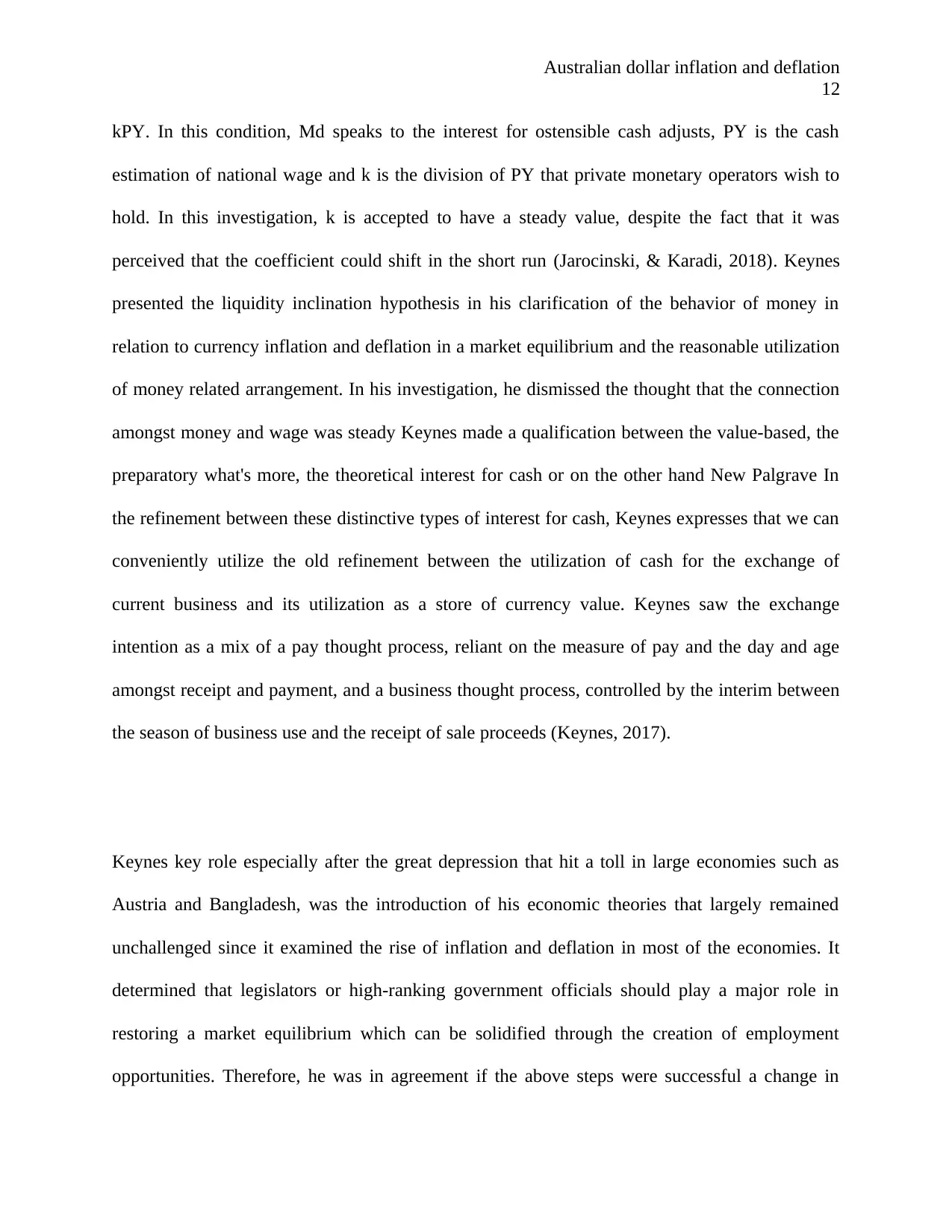
Australian dollar inflation and deflation
12
kPY. In this condition, Md speaks to the interest for ostensible cash adjusts, PY is the cash
estimation of national wage and k is the division of PY that private monetary operators wish to
hold. In this investigation, k is accepted to have a steady value, despite the fact that it was
perceived that the coefficient could shift in the short run (Jarocinski, & Karadi, 2018). Keynes
presented the liquidity inclination hypothesis in his clarification of the behavior of money in
relation to currency inflation and deflation in a market equilibrium and the reasonable utilization
of money related arrangement. In his investigation, he dismissed the thought that the connection
amongst money and wage was steady Keynes made a qualification between the value-based, the
preparatory what's more, the theoretical interest for cash or on the other hand New Palgrave In
the refinement between these distinctive types of interest for cash, Keynes expresses that we can
conveniently utilize the old refinement between the utilization of cash for the exchange of
current business and its utilization as a store of currency value. Keynes saw the exchange
intention as a mix of a pay thought process, reliant on the measure of pay and the day and age
amongst receipt and payment, and a business thought process, controlled by the interim between
the season of business use and the receipt of sale proceeds (Keynes, 2017).
Keynes key role especially after the great depression that hit a toll in large economies such as
Austria and Bangladesh, was the introduction of his economic theories that largely remained
unchallenged since it examined the rise of inflation and deflation in most of the economies. It
determined that legislators or high-ranking government officials should play a major role in
restoring a market equilibrium which can be solidified through the creation of employment
opportunities. Therefore, he was in agreement if the above steps were successful a change in
12
kPY. In this condition, Md speaks to the interest for ostensible cash adjusts, PY is the cash
estimation of national wage and k is the division of PY that private monetary operators wish to
hold. In this investigation, k is accepted to have a steady value, despite the fact that it was
perceived that the coefficient could shift in the short run (Jarocinski, & Karadi, 2018). Keynes
presented the liquidity inclination hypothesis in his clarification of the behavior of money in
relation to currency inflation and deflation in a market equilibrium and the reasonable utilization
of money related arrangement. In his investigation, he dismissed the thought that the connection
amongst money and wage was steady Keynes made a qualification between the value-based, the
preparatory what's more, the theoretical interest for cash or on the other hand New Palgrave In
the refinement between these distinctive types of interest for cash, Keynes expresses that we can
conveniently utilize the old refinement between the utilization of cash for the exchange of
current business and its utilization as a store of currency value. Keynes saw the exchange
intention as a mix of a pay thought process, reliant on the measure of pay and the day and age
amongst receipt and payment, and a business thought process, controlled by the interim between
the season of business use and the receipt of sale proceeds (Keynes, 2017).
Keynes key role especially after the great depression that hit a toll in large economies such as
Austria and Bangladesh, was the introduction of his economic theories that largely remained
unchallenged since it examined the rise of inflation and deflation in most of the economies. It
determined that legislators or high-ranking government officials should play a major role in
restoring a market equilibrium which can be solidified through the creation of employment
opportunities. Therefore, he was in agreement if the above steps were successful a change in
⊘ This is a preview!⊘
Do you want full access?
Subscribe today to unlock all pages.

Trusted by 1+ million students worldwide
1 out of 32
Related Documents
Your All-in-One AI-Powered Toolkit for Academic Success.
+13062052269
info@desklib.com
Available 24*7 on WhatsApp / Email
![[object Object]](/_next/static/media/star-bottom.7253800d.svg)
Unlock your academic potential
Copyright © 2020–2025 A2Z Services. All Rights Reserved. Developed and managed by ZUCOL.





